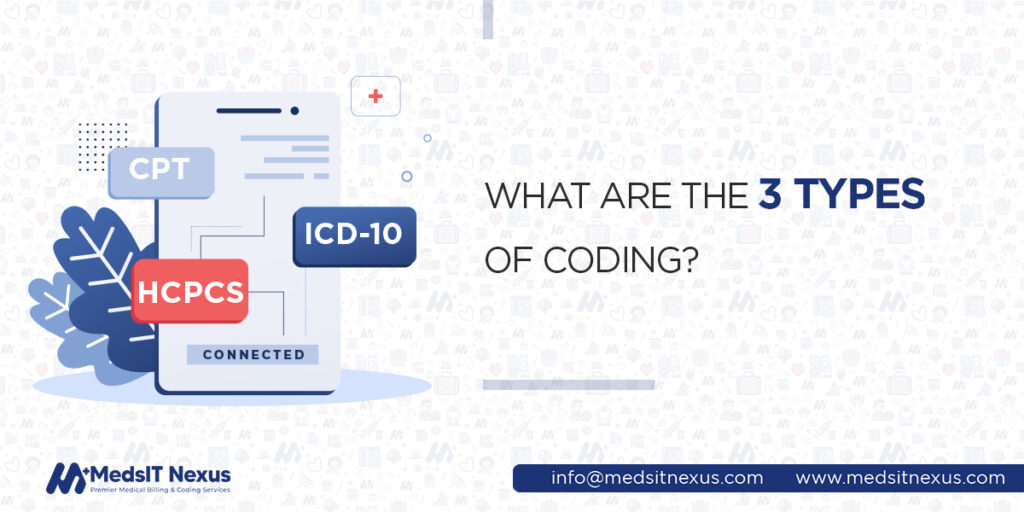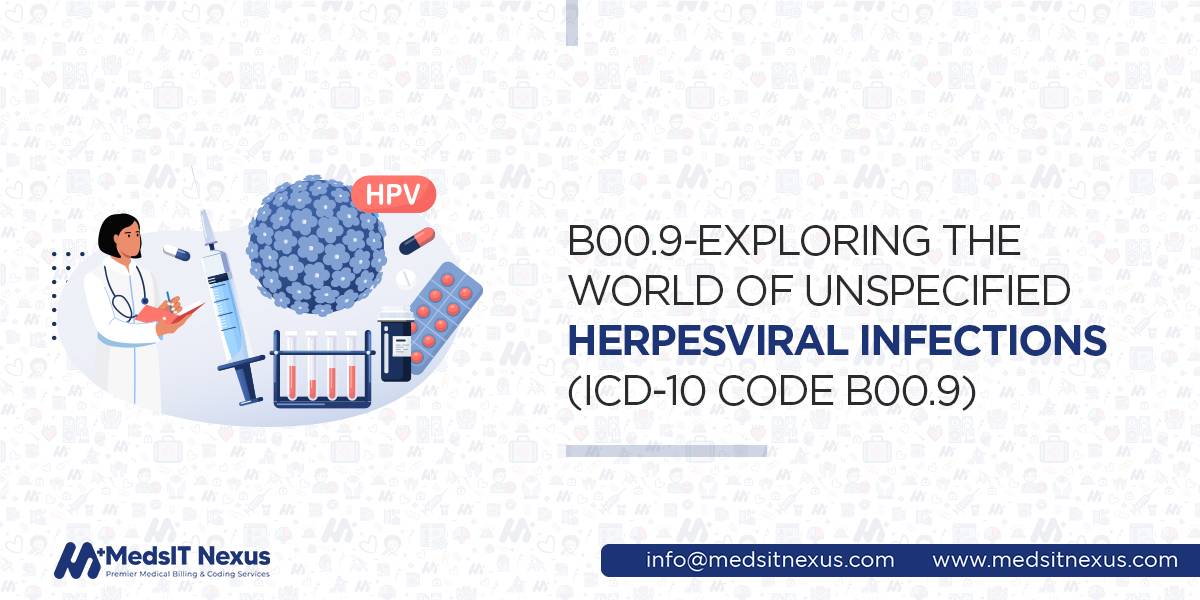What are the 3 Types of Medical Coding?

Medical coding is a critical process in healthcare, serving as the
backbone of accurate and efficient healthcare delivery. With the passage of time and advancement in the
medical field, the necessity of coding is also growing. Proper coding requires the implementation of the
correct codes so that the claims are not denied, and revenue is maintained. It is the duty of medical
coders to perform this task carefully to avoid any issues; therefore, medical organizations prefer to
shake hands with professional coders who understand the set of codes and the guidelines to use them.
Understanding the different types of medical coding is essential for healthcare professionals,
administrators, and aspiring coders; this article delves into the three critical types of medical
coding, shedding light on their distinct purposes and how they contribute to efficient healthcare
operations. Whether you are new to the field or seeking to enhance your knowledge, join us as we explore
the intricacies of procedural coding, diagnostic coding, and the comprehensive world of reimbursement
coding.
Types of Medical Coding and How they are Used
According to AAPC, Medical coding is a specialized process that involves translating medical diagnoses,
procedures, treatments, and services into standardized codes to submit claims to the patient’s insurance
companies and receive payment for the services rendered by healthcare professionals. The good news for
the coders is that it is not a dying career because, according to the U.S. Bureau of Labor Statistics,
employment of medical records and health information technicians, which includes medical coders, is
projected to grow 7%
from 2021 to 2031, much faster than the average for all occupations.
Adding to this, three primary types of medical coding are used in the healthcare industry, each with
its
own importance.
CPT
Current Procedural Terminology (CPT) coding, often called Procedural coding, contains 5-digit codes developed in 1966, maintained by the American Medical Association (AMA), and widely used in the United States. This standard medical coding system involves assigning numeric or alphanumeric codes to medical procedures, treatments, and services provided to patients and is used by physicians, allied health professionals, non-physician practitioners, hospitals, outpatient facilities, and laboratories.
Types of CPT
CPT codes are organized into three categories:
Category I codes represent the most common and widely performed procedures and have six
sections, such as
- Evaluation & Management (99202–99499)
- Anesthesia (00100-01999)
- Surgery (1002-69990)
- Radiology Procedures (70010-79999)
- Pathology and Laboratory Procedures (80047-89398)
- Medicine Services and Procedures (90281-99607)
Category II codes are used for performance measurement and tracking.
Category III codes are temporary codes assigned to emerging technologies and procedures that require further evaluation.
ICD-10
It was created by the Centers for Medicare & Medicaid Services (CMS) and the National Center for Health Statistics (NCHS) and was adopted in the U.S. in 2015 before that ICD-9 was used. This system provides a standardized language for describing and categorizing diseases, injuries, and other health conditions.
Categories
It is split into two sets.
International Classification of Diseases, Tenth Revision, Clinical Modification (ICD-10-CM)
ICD, also called diagnostic coding, assigns alphanumeric codes to medical diagnoses and conditions.
These codes provide detailed information about the patient’s condition, such as the nature of the
illness, its severity, and any associated complications. As per AAPC, ICD codes are 3 to 7-character
codes, each beginning with an alpha character, and are organized into chapters that cover specific body
systems or conditions. The first three characters indicate the disease category, while the remaining
provide additional information.
For example, the ICD code for a heart attack is I21.0, with the “I” indicating the category of “diseases
of the circulatory system” and “21.0” showing the specific type of heart attack.
International Classification of Diseases, Tenth Revision, Procedure Coding System (ICD-10-PCS)
ICD-10-PCS is a specific coding system used for inpatient procedures. Each ICD-10-PCS has seven characters and is designed to capture detailed information about medical procedures performed in hospital settings.
HCPCS
The HCPCS system underwent various modifications before commercial payers officially embraced it.
Eventually, the adoption of the HCPCS system was mandated by the Health Insurance Portability and
Accountability Act (HIPAA) in 1996.
HCPCS (Healthcare Common Procedure Coding System) codes identify medical equipment, supplies, and
services not covered by CPT codes. These codes are used by Medicare, Medicaid, and other insurance
companies to reimburse healthcare providers for the cost of these items.
Categories
HCPCS codes are divided into two categories:
Level I codes are identical to CPT codes and are used to identify medical procedures
and services.
Level II codes are 5-digit, each beginning with a letter from A to V, and are used to
identify medical equipment, supplies, and services not covered by CPT codes. Its famous modifiers are
HCPCS modifier UE (used durable medical equipment) and NU modifier (new equipment).
For example,
A7037- Nasal mask used with continuous airway pressure device
J3490- Unclassified drugs
Uses of Medical Coding
In the complex healthcare landscape, medical coding is a universal language that enables effective
communication between healthcare providers, insurance companies, government agencies, and other
stakeholders. It helps streamline administrative tasks, facilitates accurate billing, and provides
valuable data for healthcare analytics.
Accurate Billing and Reimbursement: Medical coding ensures that healthcare providers are appropriately reimbursed for their services. Insurance companies rely on coded data to process
claims and determine the level of reimbursement.
Patient Records and Documentation:
Medical coding helps maintain comprehensive,
standardized patient records. Codes document a patient’s medical history, diagnoses,
treatments, medications, and other relevant information. This ensures that healthcare
providers can access accurate and organized information when making clinical decisions,
managing patient care, and sharing information with other healthcare professionals.
Research and Analysis: Medical coding enables the aggregation and
analysis of healthcare data on a large scale. Coded data can be used for
research purposes, such as analyzing disease patterns, identifying public health
trends, evaluating treatment outcomes, and conducting clinical trials.
Researchers and policymakers rely on coded data to make informed decisions and
improve healthcare delivery.
Quality care:
According to the American Academy of Professional Coders (AAPC), medical coding guarantees high-quality care for patients.
Is Medical Coding Tough?
Medical coding can be challenging due to its complexity and the required expertise level; however, it is
not impossible because it becomes less tough with education, certification, and experience.
Some significant factors that make it slightly challenging are as follows;
Industry Regulations
Medical coding is subject to numerous regulations, including privacy and security requirements outlined in the Health Insurance Portability and Accountability Act (HIPAA). Coders must adhere to these regulations to protect patient information and ensure compliance with legal and ethical standards.
Complexity of Guidelines
The guidelines associated with medical coding, such as those provided by the Centers for Medicare and Medicaid Services (CMS), can be complex and require careful interpretation.
Code Specificity
Medical codes are particular and require attention to detail. A single incorrect digit or misplaced code can lead to claim denials or reimbursement delays. Accuracy affects patient care, reimbursement, and overall healthcare revenue.
Continuous Learning
The healthcare industry constantly evolves, with new diseases, treatments, and procedures emerging regularly. Medical coders must stay updated with these changes, including revisions to coding guidelines and updates to the code sets. This necessitates continuous learning and ongoing professional development to ensure accuracy and compliance.
Dr. Sana Pervez, Pharm.D, CCS, CPC -
Clinical Compliance Advisor at MedsIT Nexus
Responsible for Medical and compliance review of all healthcare RCM and billing content before publication.






